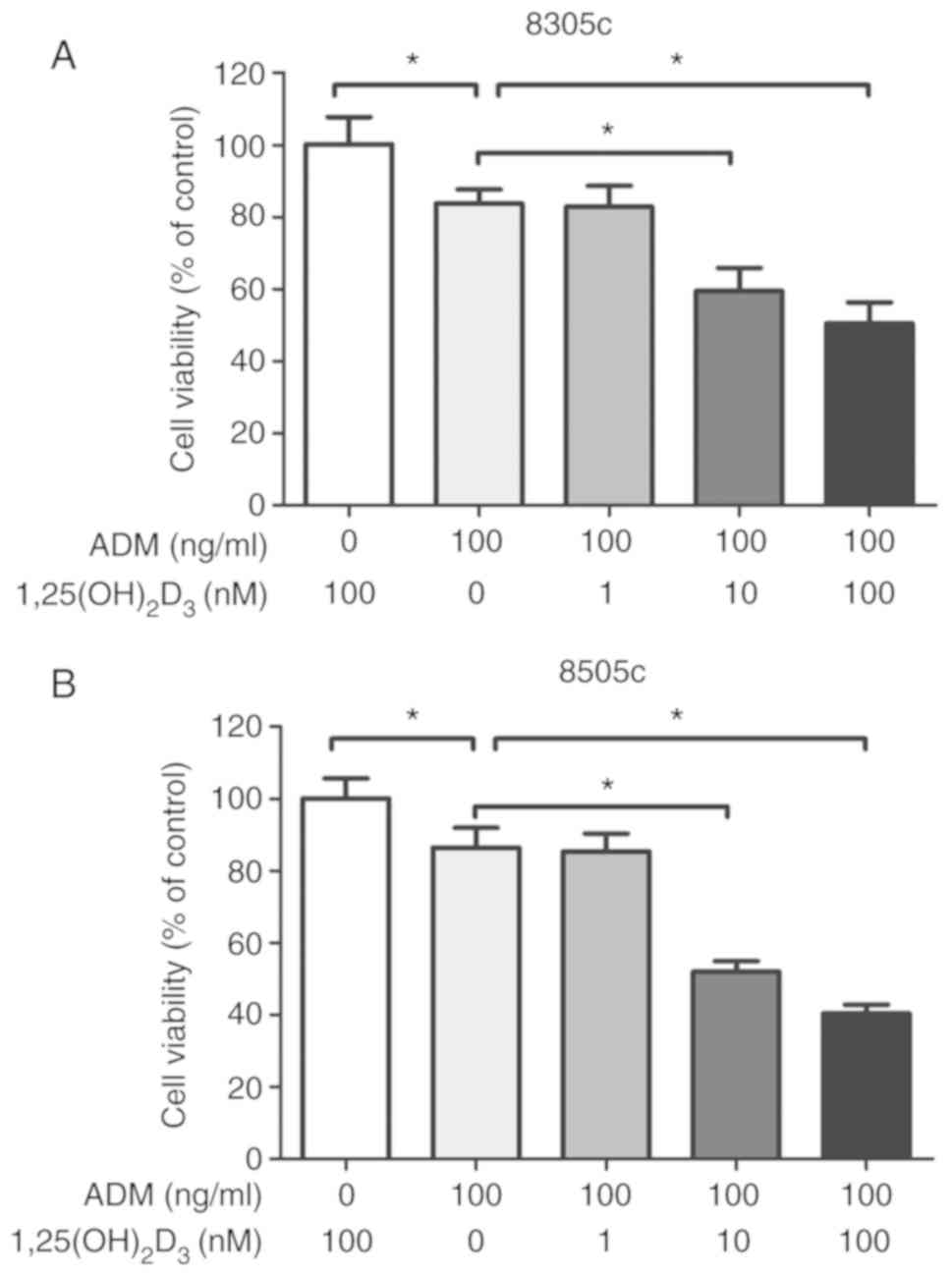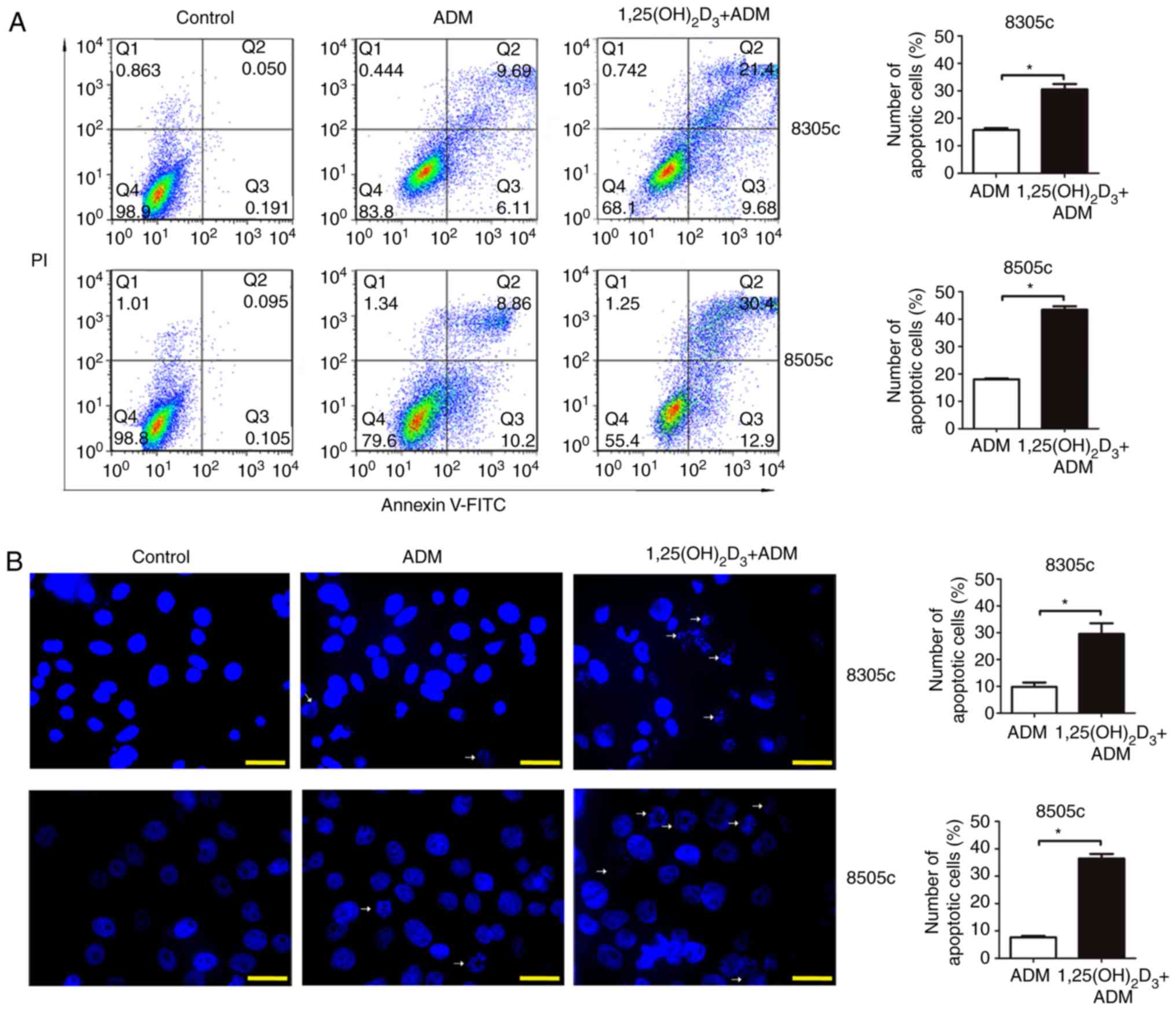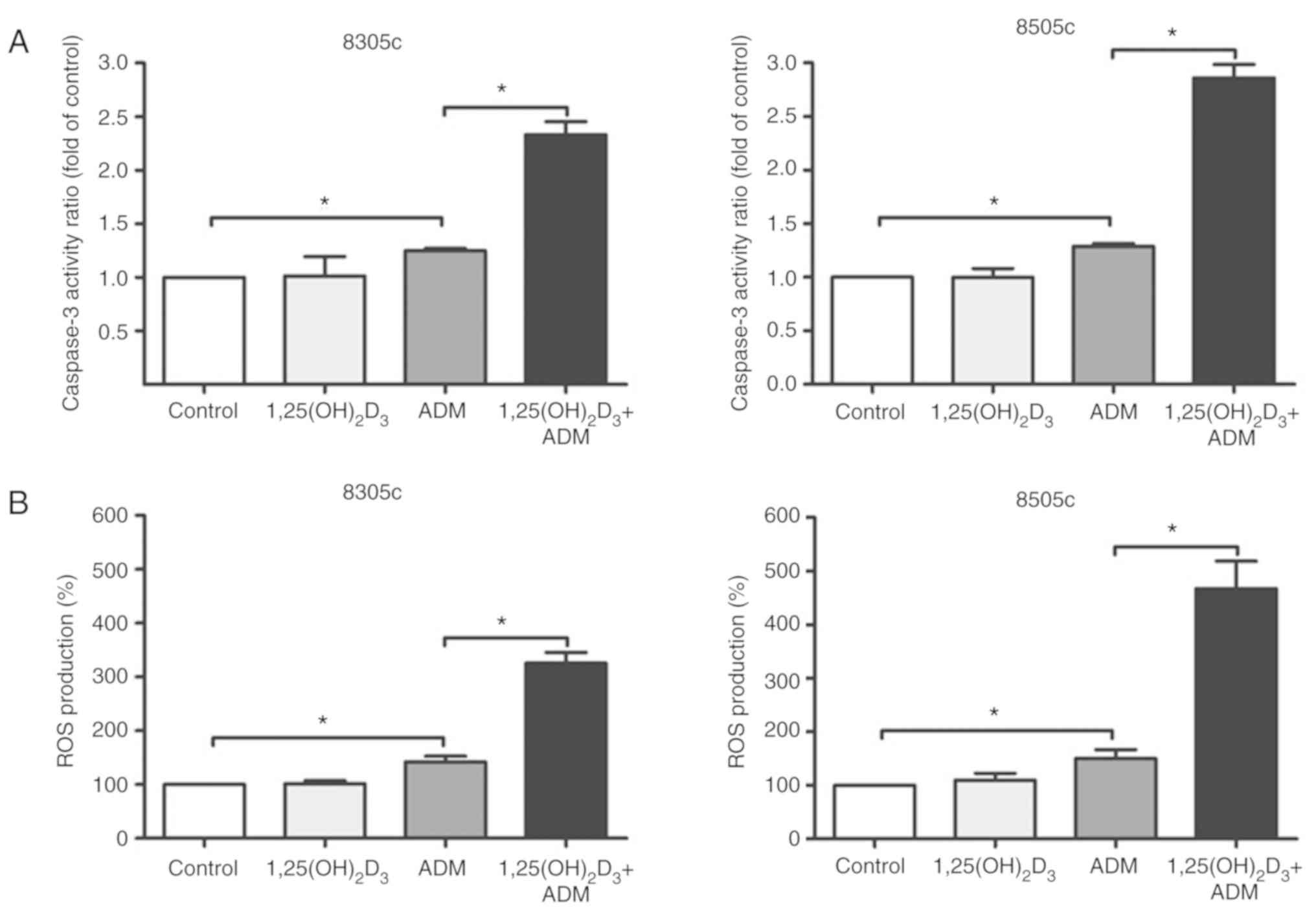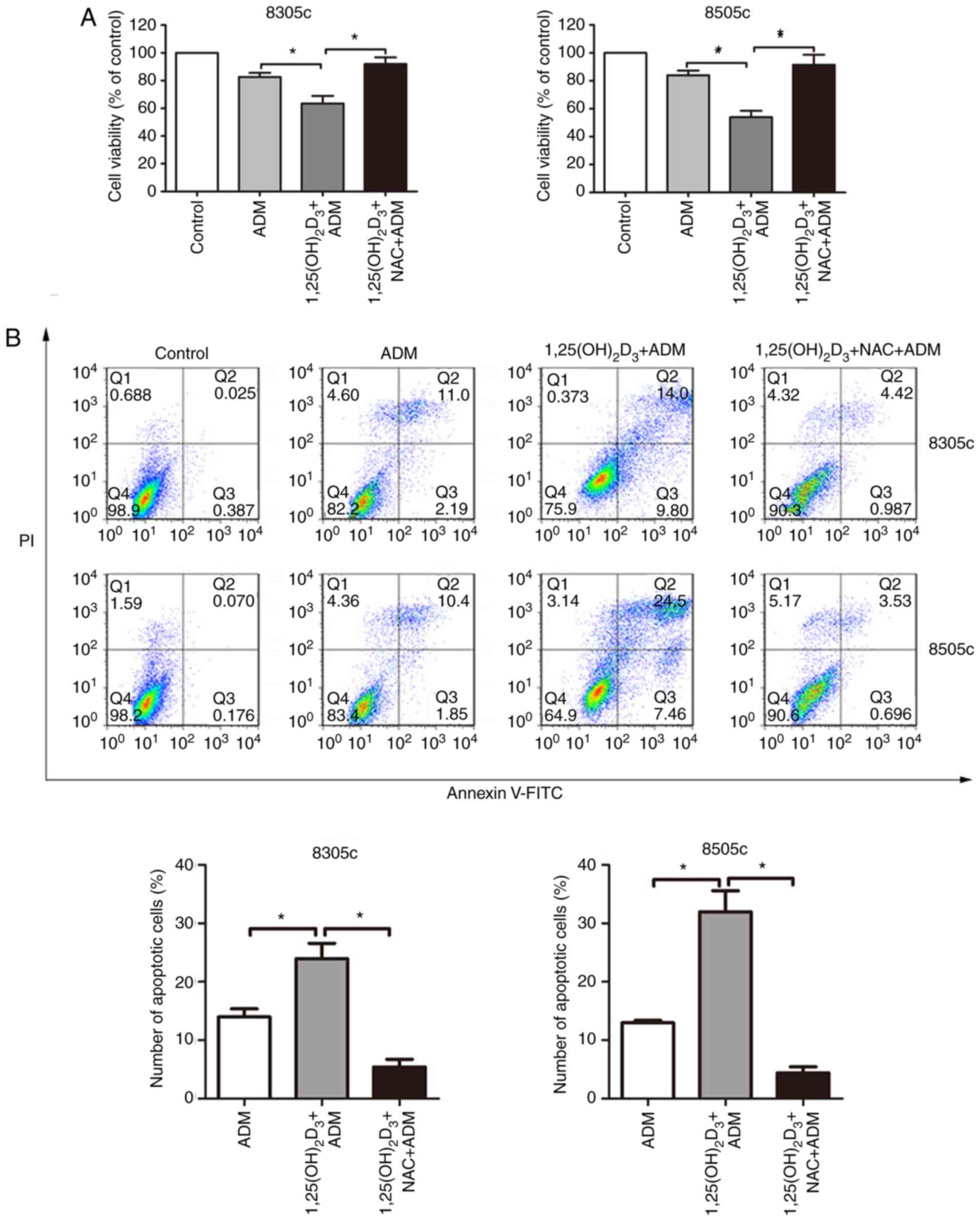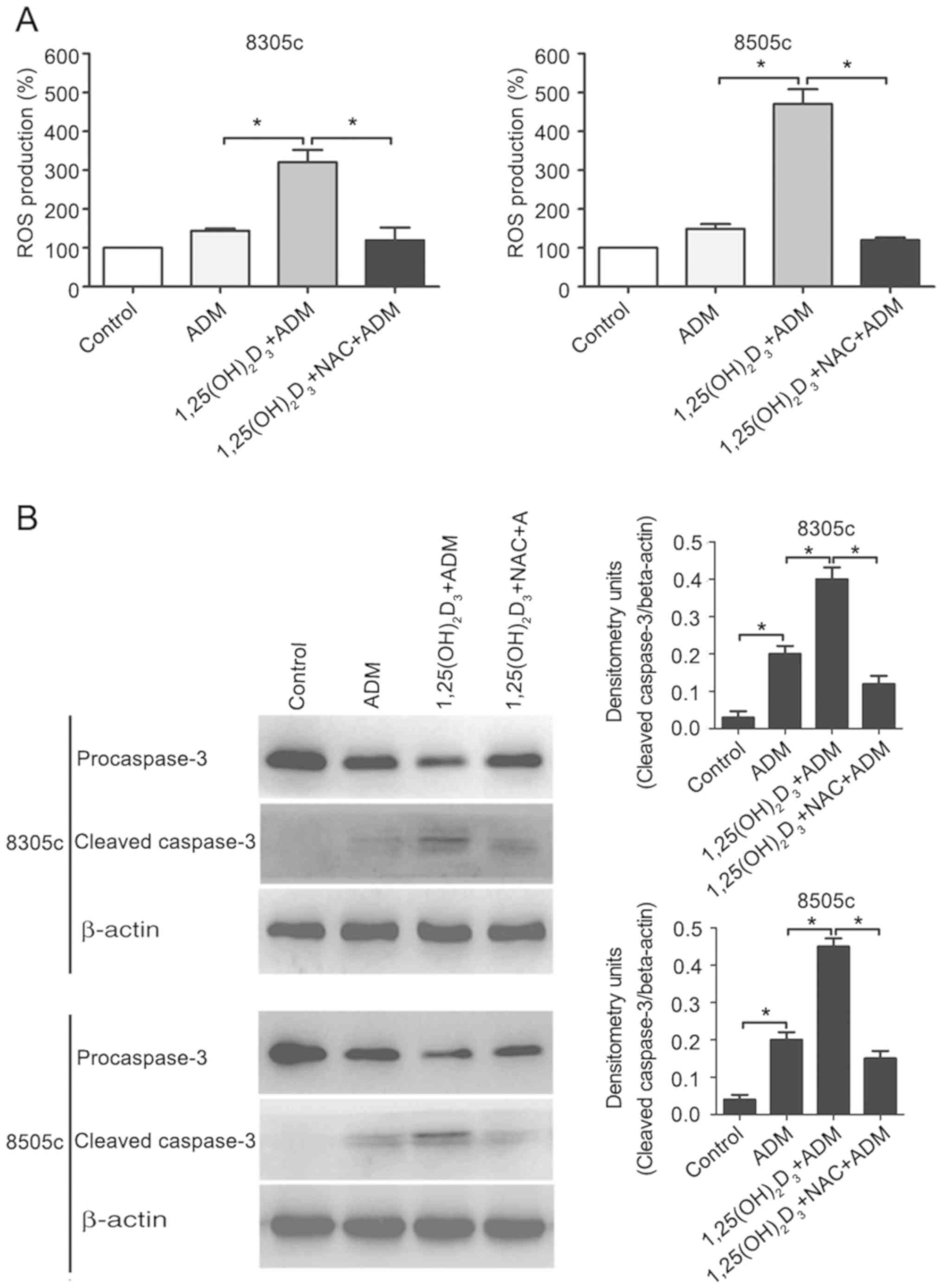|
1
|
Kasmann L, Bolm L, Janssen S and Rades D:
Prognostic factors for survival in patients treated with multimodal
therapy for anaplastic thyroid cancer. Anticancer Res.
36:4697–4700. 2016. View Article : Google Scholar : PubMed/NCBI
|
|
2
|
Nagaiah G, Hossain A, Mooney CJ,
Parmentier J and Remick SC: Anaplastic thyroid cancer: A review of
epidemiology, pathogenesis, and treatment. J Oncol.
2011:5423582011. View Article : Google Scholar : PubMed/NCBI
|
|
3
|
Smallridge RC, Ain KB, Asa SL, Bible KC,
Brierley JD, Burman KD, Kebebew E, Lee NY, Nikiforov YE, Rosenthal
MS, et al: American thyroid association guidelines for management
of patients with anaplastic thyroid cancer. Thyroid. 22:1104–1139.
2012. View Article : Google Scholar : PubMed/NCBI
|
|
4
|
Akaishi J, Sugino K, Kitagawa W, Nagahama
M, Kameyama K, Shimizu K and Ito K and Ito K: Prognostic factors
and treatment outcomes of 100 cases of anaplastic thyroid
carcinoma. Thyroid. 21:1183–1189. 2011. View Article : Google Scholar : PubMed/NCBI
|
|
5
|
Jiménez-Fonseca P, Gómez Saez JM,
Santamaria Sandi J, Capdevila J, Navarro Gonzalez E, Zafon Llopis
C, Ramón Y, Cajal Asensio T, Riesco-Eizaguirre G, Grande E and
Galofré JC: Spanish consensus for the management of patients with
anaplastic cell thyroid carcinoma. Clin Transl Oncol. 19:12–20.
2017. View Article : Google Scholar : PubMed/NCBI
|
|
6
|
Kebebew E, Greenspan FS, Clark OH, Woeber
KA and McMillan A: Anaplastic thyroid carcinoma. Treatment outcome
and prognostic factors. Cancer. 103:1330–1335. 2005. View Article : Google Scholar : PubMed/NCBI
|
|
7
|
Mitchell AL, Gandhi A, Scott-Coombes D and
Perros P: Management of thyroid cancer: United Kingdom National
Multidisciplinary Guidelines. J Laryngol Otol. 130:S150–S160. 2016.
View Article : Google Scholar : PubMed/NCBI
|
|
8
|
Smallridge RC: Approach to the patient
with anaplastic thyroid carcinoma. J Clin Endocrinol Metab.
97:2566–2572. 2012. View Article : Google Scholar : PubMed/NCBI
|
|
9
|
Haddad RI, Lydiatt WM, Ball DW, Busaidy
NL, Byrd D, Callender G, Dickson P, Duh QY, Ehya H, Haymart M, et
al: Anaplastic thyroid carcinoma, version 2.2015. J Natl Compr Canc
Netw. 13:1140–1150. 2015. View Article : Google Scholar : PubMed/NCBI
|
|
10
|
Aiken MJ, Suhag V, Garcia CA, Acio E,
Moreau S, Priebat DA, Chennupati SP and Van Nostrand D:
Doxorubicin-induced cardiac toxicity and cardiac rest gated blood
pool imaging. Clin Nucl Med. 34:762–767. 2009. View Article : Google Scholar : PubMed/NCBI
|
|
11
|
Yang L, Wu L, Du S, Hu Y, Fan Y and Ma J:
1,25(OH)2D3 inhibits high glucose-induced apoptosis and ROS
production in human peritoneal mesothelial cells via the MAPK/P38
pathway. Mol Med Rep. 14:839–844. 2016. View Article : Google Scholar : PubMed/NCBI
|
|
12
|
Ma Y, Trump DL and Johnson CS: Vitamin D
in combination cancer treatment. J Cancer. 1:101–107. 2010.
View Article : Google Scholar : PubMed/NCBI
|
|
13
|
Xian M, Cao H, Cao J, Shao X, Zhu D, Zhang
N, Huang P, Li W, Yang B, Ying M and He Q: Bortezomib sensitizes
human osteosarcoma cells to adriamycin-induced apoptosis through
ROS-dependent activation of p-eIF2α/ATF4/CHOP axis. Int J Cancer.
141:1029–1041. 2017. View Article : Google Scholar : PubMed/NCBI
|
|
14
|
Chaudhry M, Sundaram S, Gennings C, Carter
H and Gewirtz DA: The vitamin D3 analog, ILX-23-7553, enhances the
response to adriamycin and irradiation in MCF-7 breast tumor cells.
Cancer Chemother Pharmacol. 47:429–436. 2001. View Article : Google Scholar : PubMed/NCBI
|
|
15
|
Hanušová V, Caltová K, Svobodová H, Ambrož
M, Skarka A, Murínová N, Králová V, Tomšík P and Skálová L: The
effects of β-caryophyllene oxide and trans-nerolidol on the
efficacy of doxorubicin in breast cancer cells and breast
tumor-bearing mice. Biomed Pharmacother. 95:828–836. 2017.
View Article : Google Scholar : PubMed/NCBI
|
|
16
|
Aung LHH, Li R, Prabhakar BS and Li P:
Knockdown of Mtfp1 can minimize doxorubicin cardiotoxicity by
inhibiting Dnm1l-mediated mitochondrial fission. J Cell Mol Med.
21:3394–3404. 2017. View Article : Google Scholar : PubMed/NCBI
|
|
17
|
Sherman EJ, Lim SH, Ho AL, Ghossein RA,
Fury MG, Shaha AR, Rivera M, Lin O, Wolden S, Lee NY and Pfister
DG: Concurrent doxorubicin and radiotherapy for anaplastic thyroid
cancer: A critical re-evaluation including uniform pathologic
review. Radiother Oncol. 101:425–430. 2011. View Article : Google Scholar : PubMed/NCBI
|
|
18
|
Garg M, Kanojia D, Mayakonda A, Ganesan
TS, Sadhanandhan B, Suresh S, S S, Nagare RP, Said JW, Doan NB, et
al: Selinexor (KPT-330) has antitumor activity against anaplastic
thyroid carcinoma in vitro and in vivo and enhances sensitivity to
doxorubicin. Sci Rep. 7:97492017. View Article : Google Scholar : PubMed/NCBI
|
|
19
|
Sharma V, Fretwell D, Crees Z, Kerege A
and Klopper JP: Thyroid cancer resistance to vitamin D receptor
activation is associated with 24-hydroxylase levels but not the ff
FokI polymorphism. Thyroid. 20:1103–1111. 2010. View Article : Google Scholar : PubMed/NCBI
|
|
20
|
Clinckspoor I, Verlinden L, Overbergh L,
Korch C, Bouillon R, Mathieu C, Verstuyf A and Decallonne B:
1,25-dihydroxyvitamin D3 and a superagonistic analog in combination
with paclitaxel or suberoylanilide hydroxamic acid have potent
antiproliferative effects on anaplastic thyroid cancer. J Steroid
Biochem Mol Biol. 124:1–9. 2011. View Article : Google Scholar : PubMed/NCBI
|
|
21
|
Chiang KC, Kuo SF, Chen CH, Ng S, Lin SF,
Yeh CN, Chen LW, Takano M, Chen TC, Juang HH, et al: MART-10, the
vitamin D analog, is a potent drug to inhibit anaplastic thyroid
cancer cell metastatic potential. Cancer Lett. 369:76–85. 2015.
View Article : Google Scholar : PubMed/NCBI
|
|
22
|
Wang Z, Wang J, Xie R, Liu R and Lu Y:
Mitochondria-derived reactive oxygen species play an important role
in Doxorubicin-induced platelet apoptosis. Int J Mol Sci.
16:11087–11100. 2015. View Article : Google Scholar : PubMed/NCBI
|
|
23
|
Rogalska A, Gajek A, Szwed M, Jozwiak Z
and Marczak A: The role of reactive oxygen species in WP
631-induced death of human ovarian cancer cells: A comparison with
the effect of doxorubicin. Toxicol In Vitro. 25:1712–1720. 2011.
View Article : Google Scholar : PubMed/NCBI
|
|
24
|
Atashi F, Modarressi A and Pepper MS: The
role of reactive oxygen species in mesenchymal stem cell adipogenic
and osteogenic differentiation: A review. Cells Dev. 24:1150–1163.
2015. View Article : Google Scholar
|
|
25
|
Zhang L, Wang G, Chen X, Xue X, Guo Q, Liu
M and Zhao J: Formyl peptide receptors promotes neural
differentiation in mouse neural stem cells by ROS generation and
regulation of PI3K-AKT signaling. Sci Rep. 7:2062017. View Article : Google Scholar : PubMed/NCBI
|
|
26
|
Blanco J, Tomás-Hernández S, García T,
Mulero M, Gómez M, Domingo JL and Sánchez DJ: Oral exposure to
silver nanoparticles increases oxidative stress markers in the
liver of male rats and deregulates the insulin signalling pathway
and p53 and cleaved caspase 3 protein expression. Food Chem
Toxicol. 115:398–404. 2018. View Article : Google Scholar : PubMed/NCBI
|
|
27
|
Zhou D, Shao L and Spitz DR: Reactive
oxygen species in normal and tumor stem cells. Adv Cancer Res.
122:1–67. 2014. View Article : Google Scholar : PubMed/NCBI
|
|
28
|
Redza-Dutordoir M and Averill-Bates DA:
Activation of apoptosis signalling pathways by reactive oxygen
species. Biochim Biophys Acta. 1863:2977–2992. 2016. View Article : Google Scholar : PubMed/NCBI
|
|
29
|
Pan WY, Lin KJ, Huang CC, Chiang WL, Lin
YJ, Lin WC, Chuang EY, Chang Y and Sung HW: Localized
sequence-specific release of a chemopreventive agent and an
anticancer drug in a time-controllable manner to enhance
therapeutic efficacy. Biomaterials. 101:241–250. 2016. View Article : Google Scholar : PubMed/NCBI
|
|
30
|
Bondza-Kibangou P, Millot C, El Khoury V
and Millot JM: Antioxidants and doxorubicin supplementation to
modulate CD14 expression and oxidative stress induced by vitamin D3
and seocalcitol in HL60 cells. Oncol Rep. 18:1513–1519.
2007.PubMed/NCBI
|
|
31
|
Teixeira TM, da Costa DC, Resende AC,
Soulage CO, Bezerra FF and Daleprane JB: Activation of
Nrf2-antioxidant signaling by 1,25-Dihydroxycholecalciferol
prevents leptin-induced oxidative stress and inflammation in human
endothelial cells. J Nutr. 147:506–513. 2017. View Article : Google Scholar : PubMed/NCBI
|
|
32
|
Rogalska A, Koceva-Chyła A and Jóźwiak Z:
Aclarubicin-induced ROS generation and collapse of mitochondrial
membrane potential in human cancer cell lines. Chem Biol Interact.
176:58–70. 2008. View Article : Google Scholar : PubMed/NCBI
|
|
33
|
Gillissen B, Richter A, Richter A,
Preissner R, Schulze-Osthoff K, Essmann F and Daniel PT:
Bax/Bak-independent mitochondrial depolarization and reactive
oxygen species induction by sorafenib overcome resistance to
apoptosis in renal cell carcinoma. J Biol Chem. 292:6478–6492.
2017. View Article : Google Scholar : PubMed/NCBI
|
|
34
|
Guo N and Peng Z: MG132, a proteasome
inhibitor, induces apoptosis in tumor cells. Asia Pac J Clin Oncol.
9:6–11. 2013. View Article : Google Scholar : PubMed/NCBI
|



